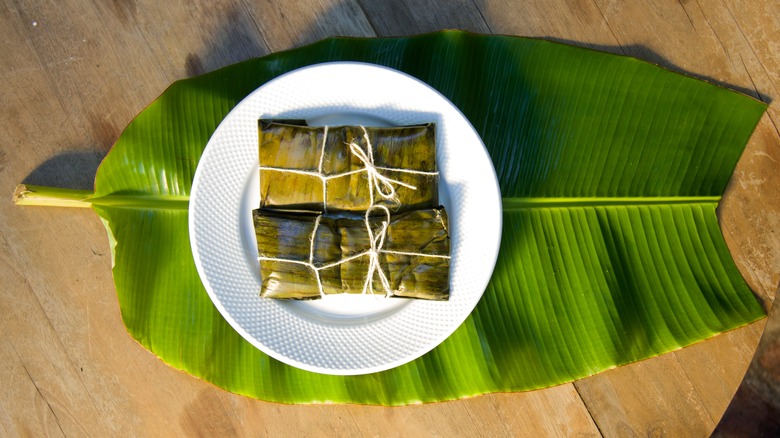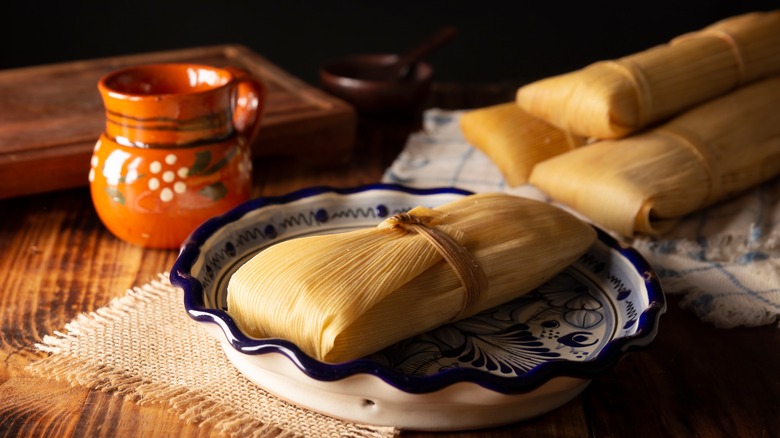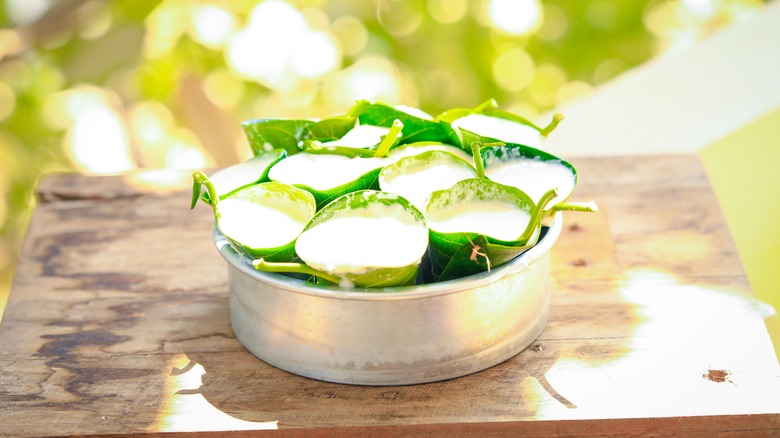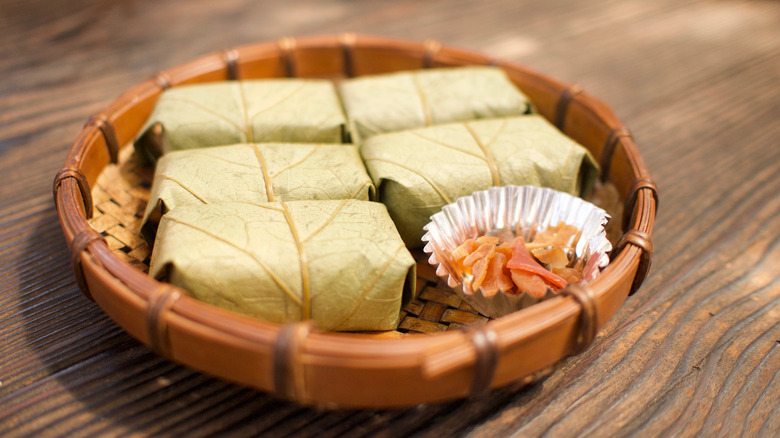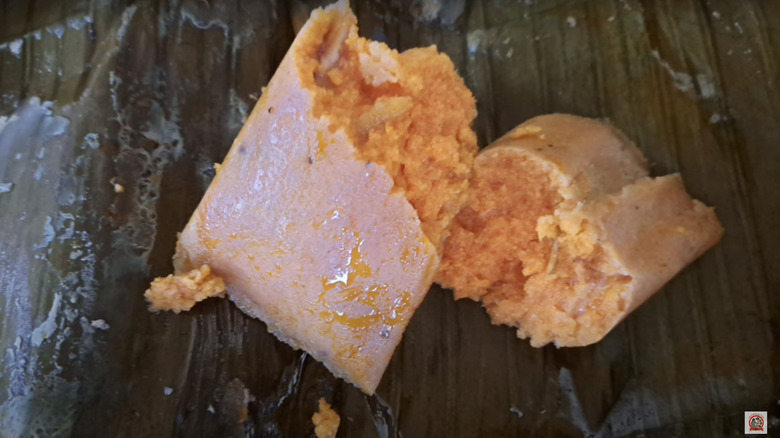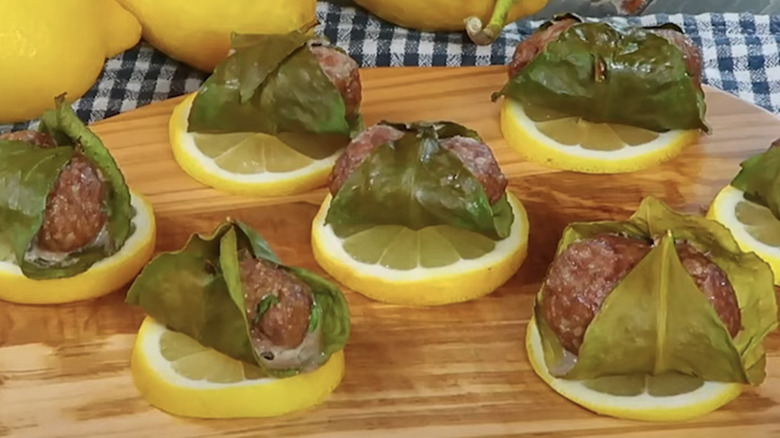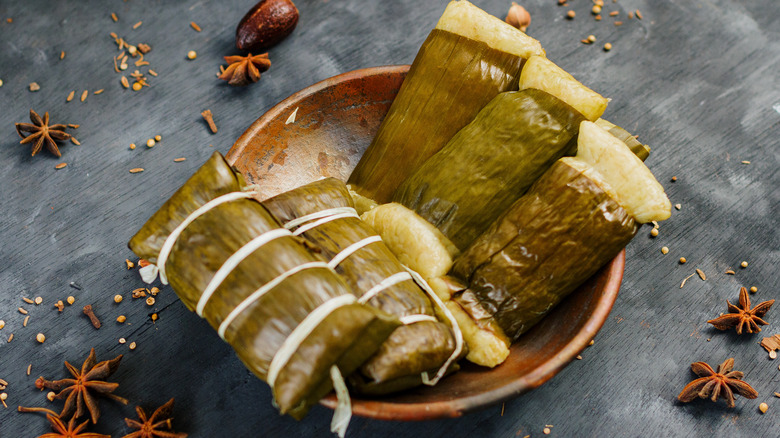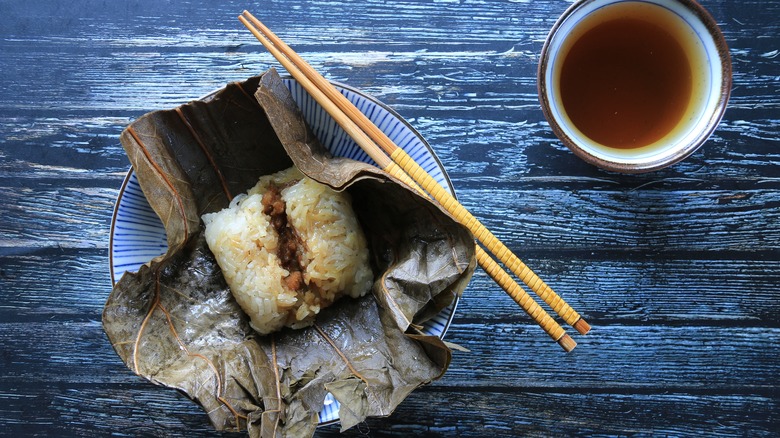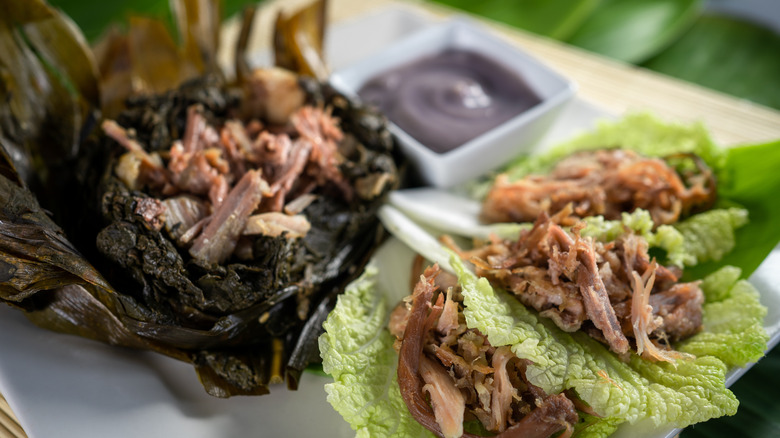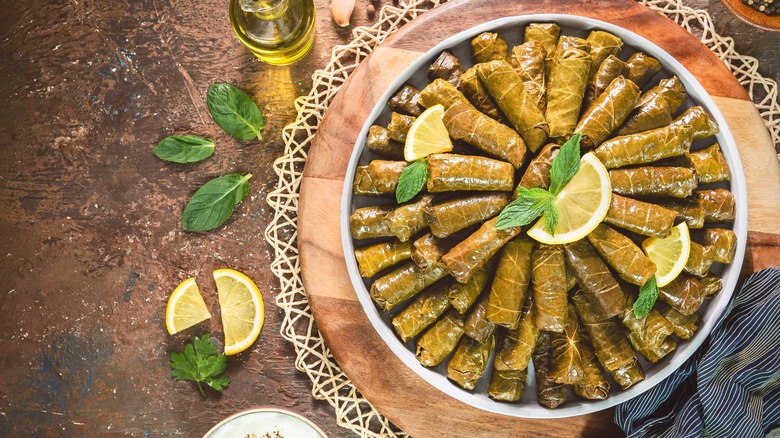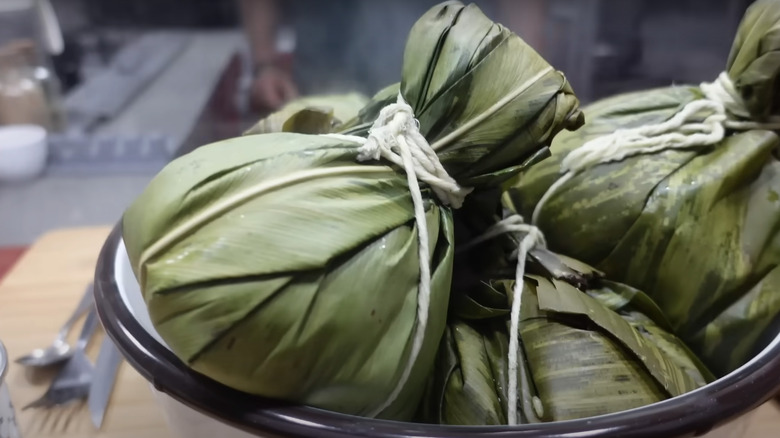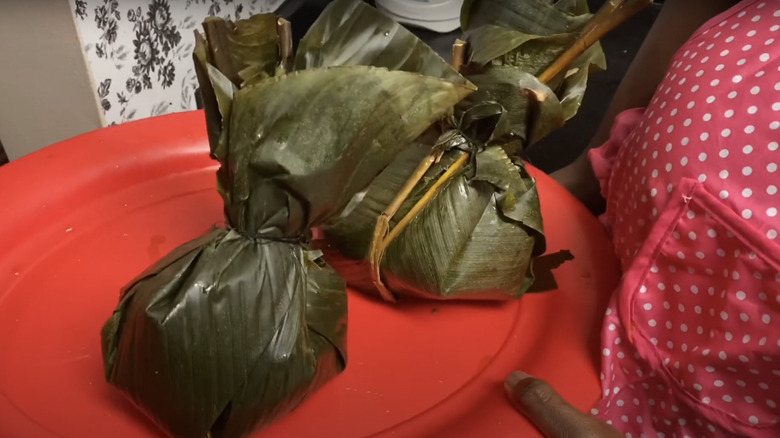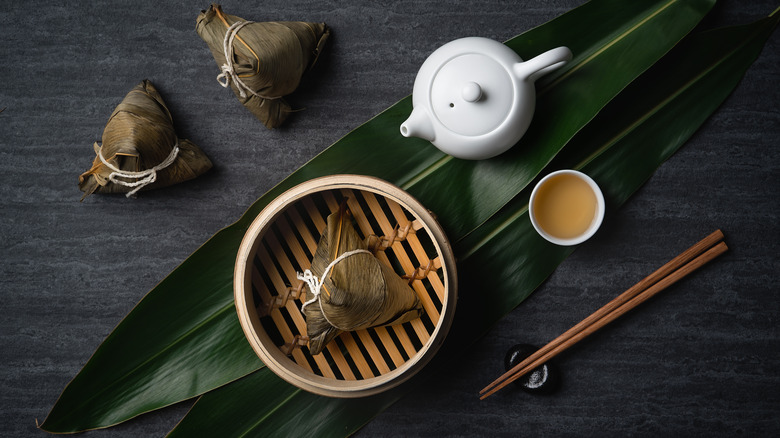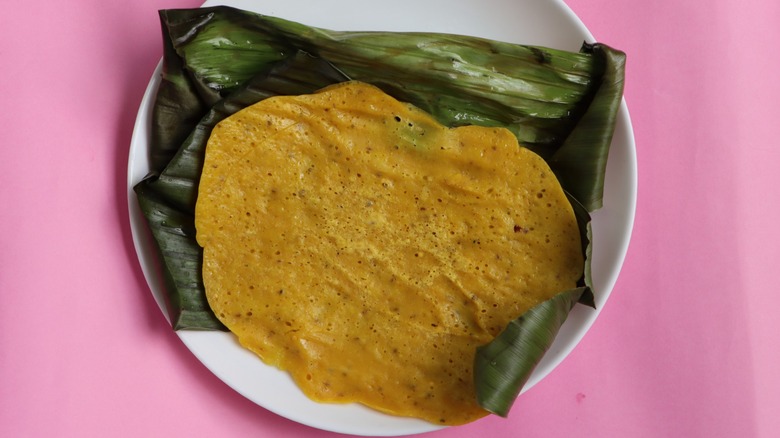13 Leaf-Wrapped Foods From Around The World
Leaves are used to wrap foods in cuisines worldwide. These natural wrappers can work very effectively during cooking, protecting the food from direct heat while trapping steam and flavor. Some leaves also impart their own distinctive flavors, giving the finished dish a unique aroma and taste. This cooking style is particularly common in countries with tropical climates, where plants tend to have larger leaves. Once wrapped, food can be cooked in a variety of ways, with the most common methods being grilling, steaming, or roasting.
Wrapping food in leaves is a truly ancient practice, which is a reason why it's used by such a variety of people worldwide. All kinds of leaves can be used this way. Regional cuisines will use different leaf types, depending on what grows locally and what flavor is desired. Some of the most commonly used ones include banana, grape, lotus, and bamboo leaves.
This method is also a convenient and biodegradable way to serve food. Street food vendors in some countries, like Singapore, serve meals on banana leaves, using the plants as one might use a paper plate. Here are just a few of the many leaf-wrapped foods from around the world.
1. Tamales
Tamales are a type of leaf-wrapped food that's beloved across Latin America– where they've been eaten for thousands of years. Their convenient wrapping — typically a plantain leaf or a corn husk — makes them easily hand-held. In turn, this makes tamales a popular choice of street food.
The basic recipe for tamales starts with masa dough, a mixture made from masa harina — a type of corn flour — and other ingredients. Once ingredients are combined to form a paste, they are wrapped around a seasoned food such as meat or vegetables. This bundle, which will comprise the tamales' filling, is then wrapped in a corn husk or other type of leaf, tied with string, and cooked. Tamales are often served with salsa. While savory tamales are probably more well-known, this dish can also be made with sweet fillings, such as dried fruit.
Certain Latin American countries are known for more specific recipes for tamales. In Guatemala, tamales colorados are filled with chicken, as well as spices like cinnamon or cloves. In Nicaragua, the tamales are made with plantain leaves, rice, potatoes, tomato, and more. Additionally, there are other types of leaf-wrapped foods in Latin America outside of tamales. Some similar dishes include the Brazilian pamonha and Venezuelan hallacas.
2. Kotte kadubu
Kotte kadubu is a type of leaf-wrapped idlis, a dish that's popular in Southern India. These small, white cakes are light, fluffy, and best served freshly steamed. They're traditionally made from a mixture of fermented rice and a batter made from lentils. During the process of cooking, the yeast involved in the process of fermentation gives the finished idlis a light, spongy texture. This dish is normally eaten savory. Idlis are often lightly seasoned with fenugreek seeds. For a light meal (usually breakfast), they're served with a selection of chutneys. However, you can make a more substantial meal out of idlis by serving them with sambar, a type of stew.
Regular idlis are made in a metal steamer. For this method, small cups are filled with the idlis batter. But with kotte kadubu, small cups are formed from jackfruit leaves. The leaves are pinned together using thin sticks of bamboo. Then, the leaf cups are filled with batter. Finally, each compartment gets cooked, usually through steam.
The leaves give the finished idlis a distinctive flavor and fragrance. Kotte kadubu is usually made during festivals in parts of India. Some variations also use other leaves, like banana, turmeric, or screwpine leaves (which are also known as kewra).
3. Kakinoha-zushi
Japan has a long history of making sushi. Over the years, many different types of sushi have been created. Some of the older sushi styles are now quite difficult to find and served only in a few specific places. Kakinoha-zushi is just such a style. Kakinoha means persimmon leaf, which is the kind of leaf this type of sushi is served in. Back during Japan's Edo period, before home refrigerators were the norm, persimmon leaves were used to keep food fresh, thanks to their antibacterial properties.
Kakinoha-zushi is a type of pressed sushi. When unwrapped, it has a similar appearance to nigiri, made from a block of rice topped with a piece of sashimi (often salmon or mackerel). Instead of being served immediately though, each piece of sushi is wrapped in a persimmon leaf, giving it a distinctive flavor.
Traditionally, these packages were placed into a basket, pressed with a heavy stone, and fermented for a few days. In modern times though, instead of this process, kakinoha-zushi is simply combined with some rice vinegar. Kakinoha-suzhi can make for a convenient takeout meal. The leaves help to keep the sushi fresh while preventing it from drying out.
4. Oleleh
Oleleh are spicy, leaf-wrapped parcels often found in the West African country of Sierra Leone. There, oleleh is a popular type of street food. You can find them sold by roadside vendors around Freetown, the country's capital. Sometimes, instead of using food trucks or carts, Freetown vendors will sell their oleleh out of baskets that they carry around on their heads.
To make oleleh, a mixture of black-eyed peas, palm oil, onion, and spices is wrapped in leaves — typically banana or kola leaves — and steamed. Scotch bonnet peppers are another popular ingredient used with oleleh, as well as seafood. For the latter, minced fish or crayfish are popular choices. A sweeter version of oleleh, known as agidi, is made with ground corn.
Other countries in West Africa also have similar dishes to oleleh. One example is the Nigerian dish of moi moi. For it, a mixture of onions, beans, and other ingredients is seasoned, wrapped in uma leaves, and cooked. Moi moi can be eaten alone, as a snack, or served as part of a more substantial meal, with some accompanying dishes.
5. Polpette con foglie di limone
The Italian dish of "polpette con foglie di limone" translates to "meatballs with lemon leaves" — and that is precisely what these tasty little treats are. Lemon leaves are tough and waxy, so you probably don't want to eat them. However, they are so aromatic that just handling them can leave a sharp fragrance on your fingers. Lemon leaves can be used to add their distinctive fragrance to a variety of recipes, including polpette con foglie di limone.
To make this leaf-wrapped dish, meat is combined with salt, black pepper, pecorino cheese, egg, and breadcrumbs to make meatballs. After the meatballs are formed, they are wrapped in lemon leaves. Unlike many other leaf-wrapped dishes, the leaves don't fully envelope these meatballs. To make sure the leaves stay on, cocktail sticks or leaf stems are used to keep everything together.
The meatballs can then be grilled, or cooked in a frying pan. The leaves protect the meat from direct heat, keeping the finished meatballs soft and succulent, while imparting a zesty aroma and taste.
6. Khao niao ping
Khao niao ping is a sweet Thai dish. It consists of sweet and gooey parcels that consist of pre-steamed sticky rice, banana, and coconut milk. Khao niao ping is made with a specific type of banana called nam was. These bananas are smaller than most, with a slightly sweeter flavor. To make khao niao ping, a mixture of banana, rice, and milk is combined, then stuffed into a banana leaf. Finally, the whole thing is grilled, until the leaf is slightly singed at the edges.
Thanks to their delicious combination of flavors, khao niao ping are a popular snack. There are also similar dishes out there, like khao tom mad, which is steamed instead of grilled. Elsewhere in Southeast Asia, other countries have slightly different versions of this dish too. In Indonesia, a dish called buras is made with sticky rice and coconut milk. It's served as a side dish, with stews and curries.
7. Lo mai gai
Dim sum is a style of Chinese cuisine often enjoyed for brunch with a pot of tea. The meal contains a variety of small, bite-sized dishes, usually served in the same bamboo steamers they were cooked in. One delicious addition to any dim sum meal is lo mai gai. This consists of big dumplings of sticky rice which are steamed inside tough lotus leaves. The rice is filled with a mixture of tasty ingredients, but the main one is chicken.
The chicken meat is usually marinated with light soy sauce, Shaoxing wine, ginger, and five spice mix. It's then stir-fried with other ingredients like mushrooms, shallots, and scallions, before being packed in steamed glutinous rice — and sometimes a few other ingredients, like salted egg yolk. The parcel is then carefully wrapped in a lotus leaf, tied, and steamed. The finished lo mai gai is a balanced meal in itself, and a couple of these can easily make a light lunch or can be part of a more filling dim sum meal.
8. Lau lau
In traditional Hawaiian cooking, ti leaves and luau (taro) leaves are vital. The big difference between the two is that luau leaves can be eaten when cooked, but ti leaves are inedible. Both leaves are involved with cooking lau lau, a much-loved Hawaiian dish. This is a firm favorite comfort food in Hawaiian cuisine. It's also a popular item to bring to gatherings.
The traditional main ingredients in lau lau are pork and butterfish, seasoned with sea salt. Modern variations also exist though, substituting pork with turkey or chicken, or even making a vegetarian version. Whatever is used for the filling, it must eventually be wrapped together in luau leaves and ti leaves, tied, and steamed. In modern cooking, lau lau is made with a rice cooker or instant pot for simplicity.
During cooking, the ti leaves trap all the moisture and flavor. This helps the luau leaves to become delicate and tender when cooked. The ti leaves are usually discarded before serving. The whole parcel can then be eaten with rice, as well as other traditional Hawaiian dishes like poi or lomi lomi salmon.
9. Dolmades
Unlike the leaves used for other leaf-wrapped foods, grape leaves are edible. Also known as vine leaves, these leaves are used to make dolmades. These consist of bite-sized bundles of rice, ground meat, herbs, and olive oil, which are stuffed into vine leaves. They are best served with a little lemon juice. If you're looking for a vegetarian option, you can also substitute chopped onion for meat. These little morsels are often enjoyed as part of Greek cuisine, in which they're a common mezze, or small appetizer.
In addition to Greece, dolmades are enjoyed in numerous countries, especially those in the Mediterranean and Middle East. Seemingly though, they're far older than any modern country, first mentioned texts from Crete over 2,000 years ago. Much later, they became a popular food in the days of the Ottoman Empire. Once a royal dish, they eventually became widely popular at all levels of society.
Most countries call these foods dolmades or dolma, but not all. In Lebanese cuisine, they're seasoned with cinnamon and go by the Arabic name of warak enab. In Iran, they're called dolmeh barg-e mo. Elsewhere, Armenians also consider dolma one of their most important national dishes. There, the food is made with butter and basil.
10. Juane
The Peruvian dish of juane is made using bijao leaves. In some places, these leaves are so popularly used in cooking that they can be found on sale at marketplaces in bundles. To make this dish, a big ball of seasoned rice, oregano, cumin, and vibrant yellow turmeric is combined. Inside this rice layer, you'll find foods like chicken, black olives, and boiled egg. When wrapped, the whole package will be tied with a single piece of string at the top. When cooked and ready to serve, the string can be cut, allowing the leaves to unfold like an opening flower, revealing their delicious contents. As well as bijao, other large leaves like bananas can also be used.
The practice of cooking food wrapped in broad bijao leaves is said to originate with the Indigenous peoples of Peru. The name for this dish, juane, likely derives from the Quechuas — an Indigenous Peruvian group. In Quechua, the word "huanar" refers to the usual cooking style of slow-steaming foods. The name changed when Spanish missionaries arrived.
11. Liboke De Poisson
Eaten throughout the Congo basin — a region of Central Africa –liboké de poisson is a dish of fish cooked in banana leaves. The fish of choice is catfish, and it can either be cooked in filets or wrapped up whole. It's usually seasoned with garlic, ginger, and onion, though there are plenty of regional variations with other seasonings, like parsley and hot peppers. Vegetables like okra or sorrel leaves can also be added.
During cooking, the banana leaves impart their own flavor to the mild taste of the fish, as well as trapping in steam to give the fish a beautifully succulent finished texture — it's essential to tie the leaf carefully to keep too much steam from leaking out. The filled leaf can be baked in an oven or cooked on a grill, directly over an open fire.
Liboké is a Congolese cooking style used for a variety of foods. While Liboké de poisson is the most popular dish made this way, the same style can be used to cook chicken or red meat.
12. Zongzi
Also known as joong in Cantonese, zongzi consists of parcels of rice wrapped in bamboo leaves. The dish is served every summer, especially during the Dragon Boat Festival. Many of the most popular Chinese foods have a legend behind them, and the story behind zongzi goes that they were originally made to honor the death of the ancient Chinese poet Qu Yuan. As an offering, rice was thrown into the river, and people eventually started wrapping the rice in leaves to keep it from being eaten by dragons living under the water.
These leaf-wrapped parcels are full of sticky glutinous rice. Inside the rice, there are several other ingredients, including marinated pork, salted duck egg yolks, mushrooms, chestnuts, and slices of Chinese cured sausage. Alternatively, a sweet version is sometimes made, where the rice is filled with sweet red bean paste. The whole thing is then wrapped in a bamboo leaf, which gives a distinctive flavor and aroma to the rice while it's steamed. Visitors to China at the right time of year — around the time of the Dragon Boat Festival — will likely find zongzi on sale almost anywhere they go.
13. Panki
Panki is a dish from Indian cuisine. More specifically, panki is a traditional recipe from Gujarat, a region of India. It consists of a pancake cooked between two banana leaves. Like most Gujarati dishes, panki is an entirely vegetarian dish. It's popular in big cities like Mumbai.
This leaf-wrapped dish is made from a dough consisting of various ingredients, including flour. This dough is seasoned with spices like green chilis, ginger, cumin seeds, and a little turmeric, which also tints the cooked panki a bright yellow color.
The mixture is sandwiched between a pair of leaves and traditionally cooked on both sides, using a large, flat pan. Most people enjoy it served on the same leaf, giving a characteristic aroma to the dish. It's usually eaten with a little spicy green chutney. Being protected from the direct heat of the pan, freshly cooked panki have a different mouthfeel to other types of pancake. They have a soft, chewy texture.
